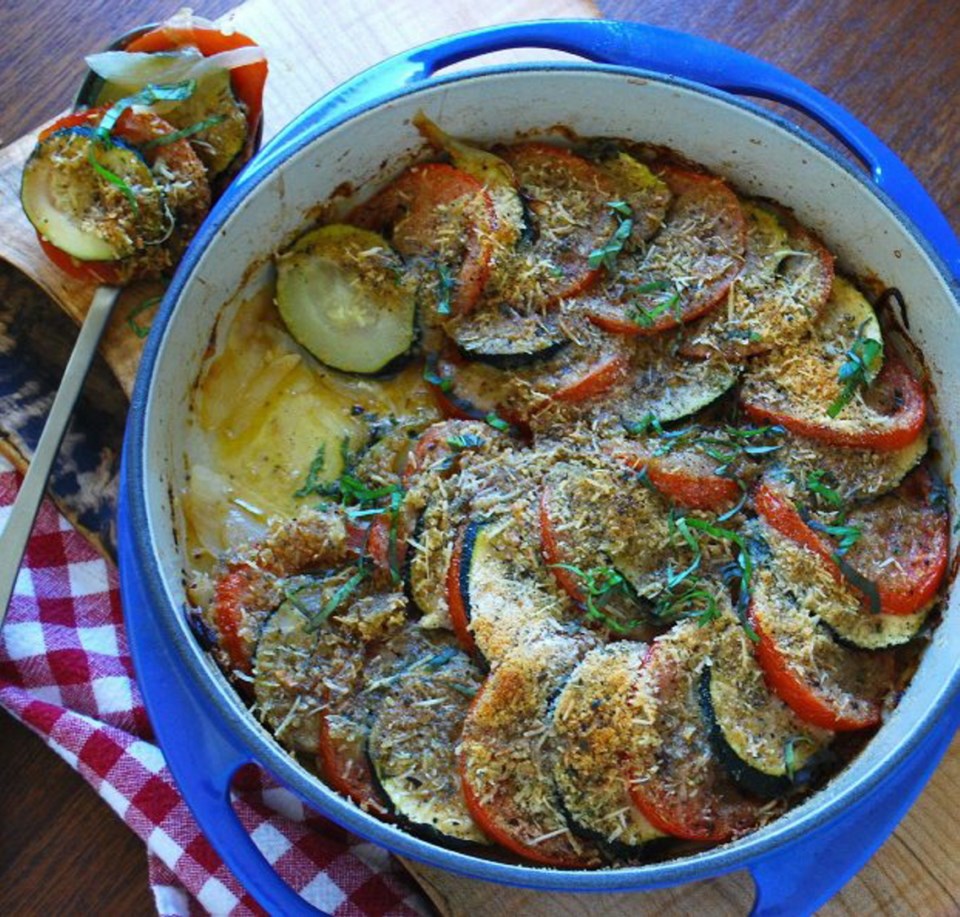 Dear Eric: Many decades ago, I heard my mother telling my father that a dish cannot be called ‚Äúau gratin‚Äù unless it is topped with breadcrumbs. At that time, he had been saying how he loved her cauliflower au gratin, which was cauliflower cooked in cheese sauce. She told him that without the breadcrumbs, it was not ‚ÄúauÃ˝gratin,‚Äù simply cauliflower with cheese sauce.
Dear Eric: Many decades ago, I heard my mother telling my father that a dish cannot be called ‚Äúau gratin‚Äù unless it is topped with breadcrumbs. At that time, he had been saying how he loved her cauliflower au gratin, which was cauliflower cooked in cheese sauce. She told him that without the breadcrumbs, it was not ‚ÄúauÃ˝gratin,‚Äù simply cauliflower with cheese sauce.
More recently, I have been puzzled by recipes in cookbooks and magazines labelled “au gratin” or “gratinée,” which consist of various ingredients cooked in cheese sauce with absolutely no mention of sprinkling breadcrumbs on the top. Has the definition of those two terms changed over the years? Or was my mother mistaken, in that something with grated cheese could also be labelled au gratin?
Nicky
Nicky, your dear mother must have learned and believed that the culinary term “au gratin” had a very narrow definition. But the truth is, most respected reference books give it a fairly broad meaning.
For example, my 1983 edition of the New Larousse Gastronomique, a book first published in 1938, states that gratin is a name given to dishes that, after being subjected to intense heat in the oven or under the grill (broiler), acquire a crisp, golden-brown crust.
That 1,064-page tome goes on to say that to assist the formation of this crust, sprinkle the food with either fresh or lightly toasted breadcrumbs. If using cheese, preferably Parmesan, pour on melted butter.
Please note the words “to assist,” because not all dishes cooked “au gratin” need to be topped with breadcrumbs or cheese or a mix of both to be given that handle.
On that point, in the Oxford Companion to Food, the authors note the phrase “au gratin” is often taken to mean “with grated cheese.” My 1975 edition of The Joy of Cooking agrees, adding that’s especially true in places such as America. But the Oxford Companion to Food says the gratin effect can be produced without adding anything on top.
The book gives a fine example of this, gratin dauphinois, a classic French dish that it says is correctly made of sliced potatoes baked in cream with no added topping. That potato dish develops its golden-brown crust simply from the heat of the oven.
With regard to the recipes you’ve been seeing in magazines and cookbooks labelled au gratin, or gratinée, another term for the process, they should only be labelled as such if they have that golden-brown crust when cooked. If they are simply cooked in cheese sauce, they have not been prepared “au gratin.”
All of the above said, I do wonder if, when your parents were having that conversation, your mother was using the Escoffier Cook Book to guide her.
Georges Auguste Escoffier, a famed French chef, restaurateur and food writer, wrote that book while updating and popularizing traditional French cooking methods in the early 1900s. The book was eventually published in North America, and my copy dates to 1969.
In that book, Escoffier describes what he calls the gratin proper as the crisp crust that forms on the surface and is a combination of the sauce below and the raspings (breadcrumbs) and butter above, under the influence of direct heat.
Escoffier, in some circumstances, does add cheese to this mixture, but in his book, he describes foods simply sprinkled with cheese that’s melted, forming a light golden crust, as being “glazed,” not “au gratin.”
So, perhaps that’s what your mother was trying to explain to your father. Cooked cauliflower is often topped with cheese sauce, topped with more cheese and popped into the oven a few minutes to melt that cheese, but not so long that it forms the rich-golden crust that foods cooked “au gratin” should have.
Ã˝
Zucchini and Tomatoes au Gratin
Two summer vegetables combine in this side dish you could serve alongside fish, lamb or kebabs.
Preparation time: 25 minutes
Cooking time: 31 to 36 minutes
Makes: six servings
Ã˝
4 Tbsp extra-virgin olive oil (divided)
1 medium onion, halved and thinly sliced
1 large garlic clove, minced
18 (1/4-inch thick) slices zucchini, cut at slight angle (see Note)
18 (1/4-inch thick) slices ripe tomato (see Note)
• salt and ground black pepper, to taste
1/2 cup loosely packed, freshly grated Parmesan cheese (not the dried powder type)
1/4 cup dried breadcrumbs
1 tsp herbes de Provence (see Note)
• thinly sliced fresh basil or Italian parsley, to taste
Ã˝
Place 2 Tbsp of the oil in 10-inch stovetop and ovenproof, pan or skillet set over medium to medium-high heat. Add the onion and cook and stir until softened, about five minutes. Mix in the garlic and cook 30 seconds more. Remove from the heat and set on a work surface.
Preheat oven to 425 F. Arrange the zucchini and tomato slices in an overlapping spiral on top of the onion; season with salt and pepper.
Combine cheese, bread crumbs and herbes de Provence in a bowl. Distribute this mixture evenly over the zucchini and tomatoes. Drizzle the cheese/crumb mixture with the remaining 2 Tbsp olive oil. Sprinkle the top of the gratin with a little more salt and pepper.
Bake in the middle of the oven 25 to 30 minutes, until the vegetables are tender and the topping rich-golden.
Sprinkle with the basil or parsley and serve.
Note: The zucchini I used for this recipe that yielded the 18 slices required was eight inches long and two inches wide. Three or four ripe, medium tomatoes should yield the slices you’ll need for this. Herbes de Provence is a French-style combination of herbs available in the bottled herb/spice aisle of most supermarkets.
Eric Akis is the author of eight cookbooks. His latest is The Great Rotisserie Chicken Cookbook (Appetite by Random House). His columns appear in the Life section Wednesday and Sunday.



